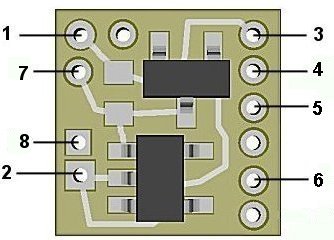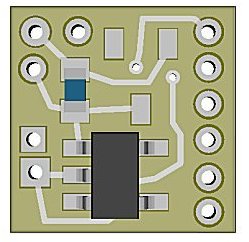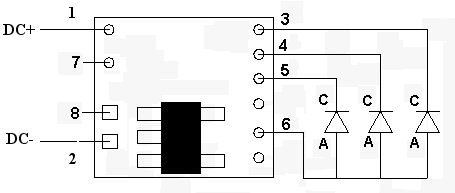Best viewed using:
Internet Explorer
or
Mozilla Firefox
Connecting the NLA8042, NLD8042 & NLA8042A, NLD8042A Rotating Beacon Simulators
Installing the NLA8042/A and NLD8042?A are very straightforward. Its tiny size and thin construction will allow it to be placed in many spaces too small for even the smallest Z-scale decoder. Because the module has circuitry on both sides, care must be taken to be sure that the components or wires soldered will not make contact with any metal object (such as a locomotive frame) causing a short circuit.
Included with the module are two 6” lengths of #32 insulated wire. If necessary, these can be used for power input wires.
NLA8042 & NLA8042A (analog) input power connections:
The NLA8042/A Simulators are configured for analog (DC) operating environments. They will function normally with track voltages ranging from 3.2 to 16-volts DC. The circuit includes a Schottky barrier diode to protect the module from reverse input voltage polarity. This means when it is wired the normal "engineer's side is the +DC track side", the effect is fully operational. when running in reverse "fireman's side is the +DC track side) the effect is not in operation. For many lighting effects, this will not be a problem because they are intended for forward operation.
For those effects that need full bi-directional operation, one of our N8101 DC Power Source circuits can be added in front of the effect simulator board to eliminate DC polarity issues. The N8101 contains a very-low voltage-drop Schottky bridge rectifier which will slightly raise the startup voltage threshold of the lighting effect by about 0.2-0.4 volts. Figure 2 below below is schematic diagram of the connections required.
All solder connections explained below

Figure 1
NLD8042 (DCC/RC) input power connections:
The NLD8042 Simulator is configured for DCC environments and sound decoders having 3.3-volt accessory functions It has an on-board jumper in place of the barrier diode used in the analog version. This allows them to operate fully at 3.3-volts (even slightly, below allowing for LED brightness). Since track polarity is not a factor in DCC the need for this protection is not required. Also, in an RC modeling environment, battery power is known so this is not an issue. However, since this family of Simulators doesn't have polarity protection, care must be taken during wiring to ensure polarity is correct before power is applied. Otherwise, the circuitry will be damaged. Figure 2 below shows the front side of the NLD8042 with the jumper installed and the barrier diode not installed.

Figure 2
Important note: A low-wattage iron with a pointed tip should be used for connection of wires. Too much heat or solder can easily damage the wires, decoder or module and void the warranty.
Also, all connecting wires should be pre-tinned before soldering them to the module. This will make connection quick and easy and ensure excessive heat is not applied to the solder points.
Connecting LEDs
When connecting the LEDs, proper polarity must be observed. LEDs are “polarity sensitive” and will not function if connected backwards. The NLA/D8042/A Simulators are configured to allow the connection of three (3) 20ma red or yellow LEDs with device voltages of 1.75-2.0 VDC. This covers Ngineering’s Micro, Nano, Subminiature and 5mm wide-angle red and yellow LEDs, as well as many red and yellow LEDs available. The N8042A Simulator is configured to connect three (3) 20 ma LEDs with device voltages of 2.8-3.3 VDC. This covers all of Ngineering’s Micro, and Nano white & blue LEDs, as well as many white & blue LEDs available.
This module will connect to 3 LEDs pre-wired and configured as described in detail in LED Construction. See Fig. 3 below for a complete overview of wiring.

Figure 3
Once again, be sure to use a low-wattage soldering iron when connecting wires to the module.
Our N40M2 12-watt Iron with either the N408I (iron clad) Needle Tip, or the N408X (bare copper) Needle Tip would be an excellent choice for this operation (or any DCC decoder work).
This completes hookup of our NLA/D8042/A Rotating Beacon modules. We hope the added realism it provides enhances your enjoyment of the hobby.
© 2014 Ngineering





















